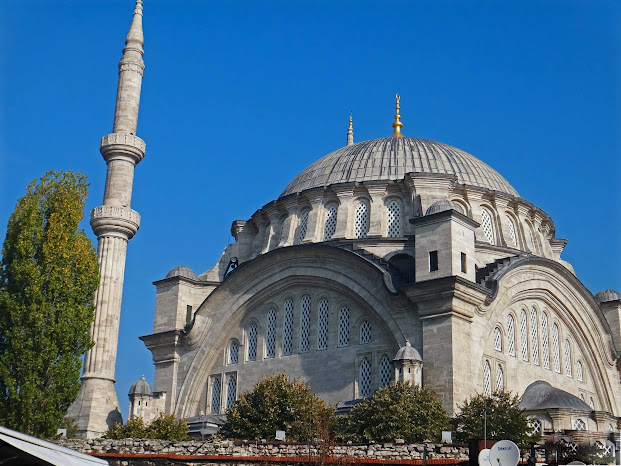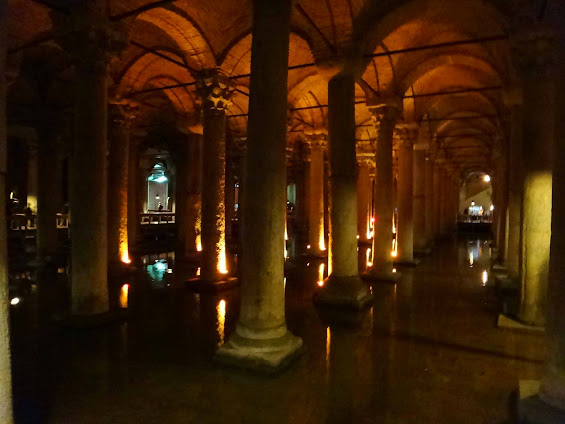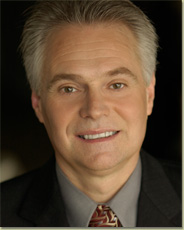November 18th 2013
The significance of Turkey. Trip of a life time. 2 of 8
 Istanbul is the only capital city located in Europe and Asia making it an unique crossroad between the West Middle East and the East. (means when you back to a Western airport, you get double scanned). Having sat out WW2 as a neutral , the country is the most Westernized Islamic nation you can imagine. They trade a lot with The EU but do not belong, “All of the advantages and none of the debts of membership” they say in Turkey. (The UK does the same.) This is a popular vacation spot for a rising Russian middle class, and they are all over Istanbul. We visited those famous Basilica Cisterns where From Russia with Love and Skyfall were filmed.
Istanbul is the only capital city located in Europe and Asia making it an unique crossroad between the West Middle East and the East. (means when you back to a Western airport, you get double scanned). Having sat out WW2 as a neutral , the country is the most Westernized Islamic nation you can imagine. They trade a lot with The EU but do not belong, “All of the advantages and none of the debts of membership” they say in Turkey. (The UK does the same.) This is a popular vacation spot for a rising Russian middle class, and they are all over Istanbul. We visited those famous Basilica Cisterns where From Russia with Love and Skyfall were filmed.

For us, this meant our trip could not help but find us walking in famous places in the Bible, ruins from the time of the Greeks, Romans ( Cleopatra’s mineral baths at Pamukkale where you swim among the ruins – sounds hokey but it is awesome). 
Europeans do enjoy Turkey’s mineral baths. We visited the temple of the whirling dervishes in Konya and also a centuries old caravanseri (ancient Holiday Inn for camel caravans)
In this country something is recent if it is only a few hundred years old.
At th e National Museum in Ankara you will see relics from the Sumerian (who invented writing), Hittite, and Assyrian eras, the war kirtle of King Midas and more. All this is reminding us that the Tigris and Euphrates rivers were the cradles of human civilization. Museums aside, much of the country is a walk in museum that will blow your mind. This is part of our Judea-Christian heritage. (including the ravages of the Crusades)
e National Museum in Ankara you will see relics from the Sumerian (who invented writing), Hittite, and Assyrian eras, the war kirtle of King Midas and more. All this is reminding us that the Tigris and Euphrates rivers were the cradles of human civilization. Museums aside, much of the country is a walk in museum that will blow your mind. This is part of our Judea-Christian heritage. (including the ravages of the Crusades)


The Ottomans ruled Turkey for over 400 years building one of the three great world empires (Roman, Ottoman and British). It stopped at Vienna in Europe (which may be some basis for still lingering fears of Turks in much of Europe), all across North Africa, Egypt/Saudi Arabia, the Middle East to India and South.
In Istanbul the Ottomans built up lavish buildings, palaces, mosques and govt offices. The Sultan and Keeper of the Faith ( Caliph) had some wives and many ( 100s) concubines in order to birth many sons. In early days the sons would be sent off to rule provinces as governors in order to be trained to run the country. When the sultan died, the first governor to reach Istanbul became the new Sultan. Later, the sons were kept in the palaces in Istanbul. On the death of a sultan, the power struggle resulted in one winner, who then murdered all his brothers. You will see the harem – where intrigue, politics and privation were the norm and the Sultans mother ruled the roost. Now and then a concubine would find enough power and favour to be raised to wife and chief consort. The court/palace was run by black eunuchs, since fewer white than black boys survived the operation, (usually from Ethiopia, Somalia, Sudan).
In Ankara you can tour the Ataturk museum and mausoleum. 
After WW 1 (with Turkey finding itself on the losing side), the country was ripped apart ( in secret agreements) by the British, French, Italians, Greeks and Russians. This sparked the Turkish War of independence against the Allies. Ataturk rose to unite the country and almost single handedly wrenched the country into the 20th century. While we were waiting at the Izmir airport at 10 on Nov 10th, alarms went off and the whole airport, and country stopped for a minute of silence to remember Ataturk’s death (This is their Nov 11), including the playing of the national anthem while looking at a huge picture of Ataturk. Few countries would help Ataturk in rebuilding Turkey, except the Russian Communists. Thus some of Turkeys modern government structure is socialist, making it behave like some Scandinavian countries. (eg. universal Medicare, free education through university, and relatively high taxes)
In Ephesus you can visit the house where the Virgin Mary spent her last years, while the tomb of St John is nearby (he stayed by Mary in her later years).


You can stand on the arena stage where St Paul was besieged by the local merchants upset by his preachings/conversions which would affect their income from the pagan pilgrims of Ephesus. Later Paul wrote letters to the same Ephesians. Standing in the arena or walking through Ephesus made me think of Ben Hur , chariots, and Julius Caeser, You see the ruts in the stone streets. sconces for street lighting, water ducts and bathhouses.

While we were there we took in a hard to find local restaurant, and what an amazing lunch the cook put put.
We bought her cook book and have been recreating her meals at home.
Related articles

Similar Posts:
- Turkey Trip of a life time. Turkey Today. 4 of 8
- Lawrence In Arabia. War Deceit, Imperial Folly and the making of the Modern Middle East. Scott Anderson
- Turkey. Trip of a lifetime. Getting there. 8 of 8
- Turkey Trip of a lifetime. Shopping. 6 of 8
- Turkey – A trip of a lifetime November 1 to 11th 2013 1of 8
Category: Travel










